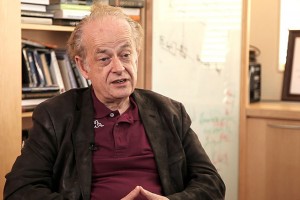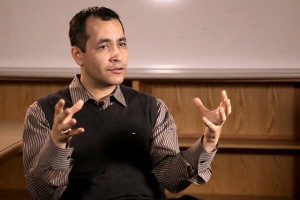Quantum Cascade Laser
Physicist Federico Capasso on semiconductor materials, industrial process control, and beam engineering

In November Advanced Materials published an article called “Self-Healing, Fully Functional, and Multiparametric Flexible Sensing Platform“. We asked the authors, Prof. Hossam Haick and Dr. Tan-Phat Huynh from the Israel Institute of Technology, to comment on this study.
The term “self-healing sensor” can be understood as a sensor which could heal or repair itself. This idea was inspired by wound healing of human skin in nature. However, healing mechanism of the sensor which we present here is different and simpler than that in nature.
Keep it in mind, a simple model of self-healing sensor was built in form of a self-healing chemiresistor. A chemiresistor, here, is a resistor its electrical resistance in response to changes in the nearby chemical and/or physical environment. This chemiresistor consists of a substrate, two electrodes, and a sensing layer. To achieve a fully self-healing chemiresistor, each part of this device should be self-healing. Therefore, the central self-healing material here is a new synthetic polyurethane and its self-healing mechanism is based on reformation of hydrogen bonds between polymer chains at two sides of the cut. Healing time and efficiency of this polyurethane depends on density of hydrogen bonds created by urea groups of polyurethane and flexibility of the polymer chains. The polymer is used as self-healing substrate and its composite with silver particles (in micron size) is worked as self-healing electrode of chemiresistor. The role of electrodes is to pass electrical current through sensing layer.
The sensing layer made of organic-capped gold nanoparticles has electrical resistance in range of hundreds of kΩ to few MΩ. The resistance of this layer varies upon the change of surrounding environments (pressure, temperature, gaseous compounds, etc.). Healing of this layer is induced by healing of the polyurethane substrate of the chemiresistor. To complete fabrication of our device, two electrical wires were connected to electrodes of the chemiresistor.
Towards demonstration of device functions, the self-healing chemiresistor was exposed to different environmental impacts, e.g., pressure or strain, volatile organic compounds, and temperature. Sensitivity of this chemiresistor to these impacts is quite comparable to state-of-the-art sensors. Important, our sensor can provide self-healing ability that has not been done earlier. The chemiresistor could survive from different kinds of cuts.

The success of this device is convergence of several different fields, i.e., material sciences, analytical chemistry, and organic electronics. Among them, sciences of self-healing polymers form the background of this study. These materials are inspired from wound self-healing of living creatures on the earth.They operated based on molecular interactions including hydrogen bonding, pi-pi stacking, metal-ligand coordination, and so on which are very well known in the field of supramolecular chemistry.
At the same time, development of sensor called its flexibility in order to enhance its application. Therefore, researchers and scientist are tending to flexible sensor where its substrate made of polymer. However, a serious problem came out with this device such as ease of suffering to damages to not only substrate but also other rigid parts (electrodes and sensing layer) of a sensor. To overcome this problem, we replaced as much as possible regular polymer by self-healing polymer to achieve a self-healing sensor.
Even though our self-healing platform was fabricated as a proof-of-concept, this reported device raises expectations that flexible devices might one day become self-administered, thus increasing their reliability in a number of applications, such as durable-transparency touch-screens, self-healing electronic skin, and cost and effort efficiency in large-scale or hard-to-reach instruments.

Physicist Federico Capasso on semiconductor materials, industrial process control, and beam engineering

Physicist Martin McCall on Maxwell's equations, hiding objects with light, and invisibility cloaks

Bioengineer Ali Khademhosseini on creating new biomaterials, microengineering, and mimicking embryonic develop...